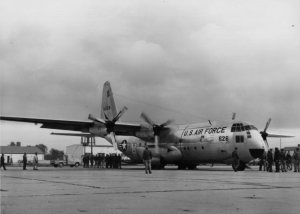

| Home page | The Wing | Magazine | Images | Technics | Events | Links |
Description:
The C-130 Hercules, a four-engine turboprop aircraft, affectionately known world-wide as "Herky", is the workhorse of the military services. Capable of landing and taking off from short, rough dirt runways, it is a people and cargo hauler and is used in a wide variety of other roles, such as gunships, weather watchers, tankers, firefighters and aerial ambulances. There are more than 40 versions of the Hercules and it is widely used by more than 50 nations.
Background:
Twelve C-130 H were delivered to the Belgian Airforce in 1972. Call sign is CH 01 up to CH 12.
General Characteristics
Primary Function: Global airlift
Contractor: Lockheed Aeronautical Systems Company, Marietta, Ga.
Power Plant: Four Allison T56-A-15 turboprops, each 4,910 horsepower
Length: 97 feet 9 inches (29.3 meters)
Height: 38 feet 3 inches (11.4 meters)
Wingspan: 132 feet 7 inches (39.7 meters)
Speed: 374 mph (Mach 0.57, 604.4 kmh) at 20,000 feet
Ceiling: 33,000 feet with 100,000 pounds (45,000 kg) payload
Maximum Takeoff Weight: 155,000 pounds (69,750 kg)
Range: 2,350 miles (2,050 nautical miles, 3,770 km) with maximum payload;
2,500 miles (2,174 nautical miles, 4,000 km) with 25,000 pounds (11,250 kg) cargo; 5,200 miles
(4,522 nautical miles, 8,320 km) with no cargo
Unit Cost: Average $44.1 million
Crew: Five: two pilots, navigator, flight engineer, loadmaster
Capacity: Up to 92 troops or 64 paratroops or 74 litter patients or five standard freight pallets
by Frank McCurdy
The Lockheed C-130 Hercules was the answer to a request for proposals submitted in 1951. Lockheed was one of six aircraft manufacturers who heeded the call. With many new innovations, the Herk was far advanced to any airlifter in service at that time. Some of its many new features included turboprop engines, truck-bed height loading ramp, and rough field landing gear.
The prototype first flew on August 23, 1954 at Burbank, California. Lockheed's own Kelly Johnson refused to sign off on the aircraft design because he felt it was too ugly and radical. That was quite a statement from the head of the famous Skunk Works!
 Production of the
aircraft was moved to Marietta, Georgia, to a facility that produced
B-29's in W.W.II and B-47's during the early fifties. The first
flight of a production C-130A was in April 1955 and the line has
not stopped since. This accomplishment has made it the aircraft
with the world's longest production run. Aircraft are still being
produced at roughly three a month..When the 2,000th airframe was
accepted by the
Production of the
aircraft was moved to Marietta, Georgia, to a facility that produced
B-29's in W.W.II and B-47's during the early fifties. The first
flight of a production C-130A was in April 1955 and the line has
not stopped since. This accomplishment has made it the aircraft
with the world's longest production run. Aircraft are still being
produced at roughly three a month..When the 2,000th airframe was
accepted by the
Kentucky Air National Guard, the first C-130A, was still in service.
Quite a record, indeed!
Over the past forty-some-odd years the Hercules has been produced or modified to over eighty variations with deliveries to over sixty countries. This greatly outnumbers its closest two rivals, the French-German C-.160 Transall and the Soviet Antonov An-12, both of which have not only been long out of production, but have also been replaced by C-130s in many cases.
While originally designed as a tactical transport for the USAF, the Herk has found many other careers it could pursue. The aircraft has been developed for use as gunships, search and rescue, various special operations, maritime patrol, snow operations, weather reconnaissance, and commercial freighter.
The Hercules has been purchased by the air arms of many foreign countries. Great Britain (which has stretched over half of its fleet), Iran and Saudi Arabia, all purchased over sixty examples of the C-130.
Along with being involved in every military operation throughout the world since its introduction, the C-130 has proven itself as a humanitarian with relief efforts all over the globe. Many soldiers owe their lives to the abilities of this aircraft. It was the workhorse of the war in Southeast Asia, providing much needed supply deliveries along with troop ingress and egress.
With upgraded models in the works, such as the new C-130J for the USAF and RAF, it seems amazing that C-130s are being replaced by C-130s. That is a new concept in the annals of aviation history. When technology improves, conventional aircraft are replaced with the improvement. While the C-130 has seen many internal improvements through the years, the packaging has remained virtually unchanged. Simply speaking, nothing better has come along.
| Home page | The Wing | Magazine | Images | Technics | Events | Links |